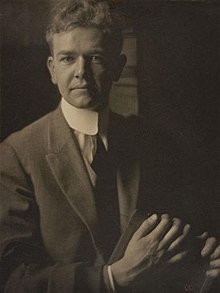Karl Struss
Karl Fischer Struss (born November 30, 1886 , New York - † December 16, 1981 , Santa Monica , CA ) was an American photographer and cameraman who, in the early days of film, played a key role in the development and with others Using the movie camera played.
Struss was the first cameraman to receive the Oscar and was nominated three more times.
Life
Karl Fischer Struss was the youngest of the six children of Henry W. Struss and his wife Marie. According to some sources, he did not finish high school because of an illness . According to other sources, he graduated from DeWitt Clinton High School in New York City . From 1903 Struss worked in his father's factory for ten years. During this time he attended evening classes in photography at Columbia University Teacher's College (from 1908). Struss studied photography for four years in total before settling in Los Angeles and running his own photo studio from 1914 to 1919.
Cecil B. DeMille hired him in 1919 . Together with Charles Rosher , Struss quickly became one of the leading cameramen in the fledgling film industry. Rosher and Struss often worked together and shared the first Oscar for Best Camera Ever in 1929 for their work on FW Murnau's Sunrise - A Song of Two People ( Sunrise ).
Many of Struss' innovations are falsely attributed to other people, such as the use of infrared filters in the metamorphosis in Dr. Jekyll and Mr. Hyde by Rouben Mamoulian (1931).
Struss trained some of the best cameramen of the 1950s, including George Clemens , who later took over the camera for the television series Twilight Zone . Until 1959, Struss was often behind the camera for the director Kurt Neumann . His penultimate film was The Fly (1958). Here he used the now famous "look through the fly's eye". Between 1960 and 1970 Struss shot only TV commercials.
Karl Fischer Struss died on December 16, 1981 in Santa Monica, California. There are always exhibitions showing Karl Struss' photographs.
Filmography (selection)
- 1925: Ben Hur (Ben-Hur: A Tale of the Christ)
- 1926 Sparrow (Sparrow)
- 1927: Sunrise - Song of Two People (Sunrise)
- 1929: The Taming of the Shrew
- 1929: Coquette
- 1931: Skippy
- 1931: Dr. Jekyll and Mr. Hyde (Dr. Jekyll and Mr. Hyde)
- 1932: Under the Sign of the Cross (The Sign of the Cross)
- 1932: The Island of Lost Souls (Iceland of Lost Souls)
- 1933: The Story of Temple Drake
- 1934: The Pursuit of Happiness
- 1936: Go West (Go West, Young Man)
- 1936: Hollywood Boulevard
- 1937: Waikiki Wedding
- 1937: Every Day's a Holiday
- 1939: Some Like It Hot
- 1939: Zenobia, the fairground elephant (Zenobia)
- 1940: Rhythm on the River
- 1940: The Great Dictator (The Great Dictator)
- 1941: Aloma, the daughter of the South Seas (Aloma of the South Seas)
- 1943: Hunted by Agents (Journey into Fear)
- 1943: Riding High
- 1946: Tarzan and the Leopard Woman
- 1946: The tire of death (Suspense)
- 1947: The affair Macomber (The Macomber Affair)
- 1949: The Lady of Atlantis (Siren of Atlantis)
- 1949: Tarzan and the Blue Valley (Tarzan's Magic Fountain)
- 1950: The Return of Jesse James
- 1950: Rocket Moon launches (Rocketship XM)
- 1951: Tarzan and the jungle goddess (Tarzan's Peril)
- 1952: spotlight (Limelight)
- 1952: Tarzan, the defender of the jungle (Tarzan's Savage Fury)
- 1953: Sicilian passion (Cavalleria rusticana)
- 1953: Tarzan breaks the chains (Tarzan and the She-Devil)
- 1954: Two Nights with Cleopatra (Two Nights with Cleopatra)
- 1956: Mohawk
- 1957: Kronos
- 1958: The Fly (The Fly)
- 1959: Death drives first class (The Rebel Set)
Struss also worked for numerous episodes of the television series Broken Arrow . In total, Struss was behind the camera for almost 140 films.
Web links
- Karl Struss in the Internet Movie Database (English)
| personal data | |
|---|---|
| SURNAME | Struss, Karl |
| ALTERNATIVE NAMES | Struss, Karl Fischer (full name) |
| BRIEF DESCRIPTION | American photographer and cameraman |
| DATE OF BIRTH | November 30, 1886 |
| PLACE OF BIRTH | New York , NY |
| DATE OF DEATH | December 16, 1981 |
| Place of death | Santa Monica , CA |
